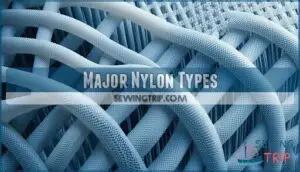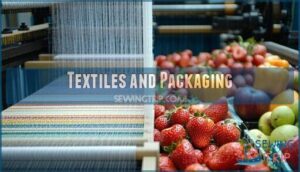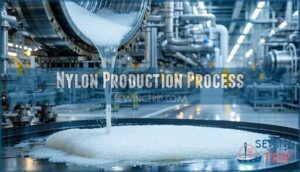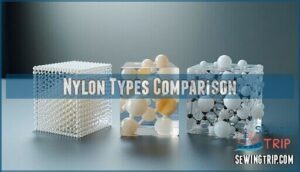This site is supported by our readers. We may earn a commission, at no cost to you, if you purchase through links.

Each kind has its own recipe of strength, flexibility, and resistance to wear.
Nylon 12 and Nylon 11 go the extra mile, handling chemicals and cold like pros.
High-performance nylons, such as PPA and PA46, take the heat in demanding uses.
Picking the right nylon is a bit like choosing a sports team—each member has strengths geared for specialty roles.
Stick around; the next section unpacks what each type really brings to the table.
Table Of Contents
Key Takeaways
- You’ll find nylon comes in several types—like Nylon 6, 66, 12, and high-performance grades—each built for specific strengths, flexibility, and resistance needs.
- Don’t assume all nylons handle the same challenges; Nylon 66 handles heat and wear best, while Nylon 12 stands out for moisture and chemical resistance.
- You have to match nylon’s properties to your project, weighing factors like melting point, tensile strength, and cost to get the best fit.
- Newer options, like bio-based and recycled nylons, let you choose materials that perform well and support sustainability goals.
What is Nylon
You’ll find that nylon is a synthetic polyamide polymer, created from repeating units of amide bonds formed by combining specific monomers, such as hexamethylenediamine and adipic acid.
Nylon is a synthetic polyamide polymer built from amide bonds, blending strength and versatility from its unique monomer building blocks.
Its many types, like Nylon 6 and 66, have unique chemical structures that give each variety distinct levels of strength, flexibility, and moisture resistance.
Definition and Chemical Composition
Nylon is all about Polyamide Chemistry—you’ll find it weaving strength into daily life.
Each nylon type starts with Monomer Structures built from Carbon Atoms.
These get stitched together through Nylon Synthesis, forming long chains with amide groups.
Whether you’re looking at traditional or Bio-Based Nylons, this polymer chemistry backbone makes nylon durable, flexible, and essential in modern materials.
Polyamide Prefix and Numbering
After learning about its makeup, understanding Nylon nomenclature is a bit like reading a secret code. The “PA” prefix stands for polyamide, but what comes after matters more.
- Numbers show monomer count (nylon 6, nylon 66)
- Numbering significance reveals polymer structure
- PA variations hint at chemical tweaks
- Different nylon types suit specific needs, which is key to understanding the polyamide structure.
Types of Nylon and Their Properties
With so many nylon types, it helps to know the basics.
You’ll spot Nylon 6 and Nylon 66, famous for great strength and high melting points.
Polyamide fibers like these handle wear resistance and offer solid chemical resistance.
Just remember—water absorption varies by type, so nylon properties change with use, and it’s good advice to match nylon strength to your needs.
Major Nylon Types
You’ll find that major nylon types, including Nylon 6, Nylon 66, Nylon 4,6, and high-performance options like PPA and PA46, differ in chemical structure, strength, and heat resistance.
Understanding the unique density, melting points, and moisture absorption rates of these polyamides helps you choose the right material for each application.
Nylon 6 and 66
When you compare nylon polymers, Nylon 6 and 66 top the list.
You’ll spot Nylon 6 properties like excellent elasticity and smooth dyeing characteristics, while Nylon 66 differences include a higher melting point and better abrasion resistance.
Production cost tends to be lower for Nylon 6, and both polyamide fibers offer solid blending options, making these Nylon types incredibly versatile.
Nylon 4,6 and 12
When picking between polymer types, Nylon 46 stands out for thermal resistance and low creep in high-heat spots—think engine parts.
You’ll find Nylon 12 flexibility shines in tubing and fuel lines, thanks to its low moisture absorption and strong chemical resistance.
Both Nylon types—Nylon 46 and Nylon 12—are thermoplastics you’ll see used for demanding, specialized needs.
High-Performance Nylons Like PPA and PA46
Exploring high-performance materials, you’ll find PPA and PA46 stand out for their temperature resistance and chemical resistance.
These nylons keep their mechanical strength above 150°C, so PPA applications often include electronics and automotive parts.
PA46 advantages stem from its thermal properties and durability, making it a go-to in high-performance applications where superior toughness, low moisture uptake, and stability are non-negotiable.
The automotive sector’s growing demand for PPA is substantially boosting the market.
Properties of Nylon
You’ll notice nylon offers impressive strength, flexibility, and a range of melting points depending on its type, like Nylon 6’s 220°C and Nylon 66’s 260°C.
Its low moisture absorption and excellent resistance to chemicals and wear make it reliable for tough environments.
Strength and Elasticity
When you get into the mechanical properties of nylon, you’ll see it’s a workhorse material.
Nylon’s high tensile strength means it stands up to stretch—think strong ropes or engineering parts.
With impressive elasticity and a solid elastic modulus, you get both flexibility and durability.
Its impact resistance, fatigue endurance, and low creep behavior make nylon reliable for daily wear and tear.
Melting Points and Water Absorption
You’ll notice nylon grades each have a unique melting point—Nylon 6 melts at 220°C, while Nylon 66 holds up to 265°C.
These numbers matter for Temperature Stability and Application Suitability.
Watch out for nylon moisture absorption; some grades soak up water, causing dimensional changes.
Use proper Drying Methods to avoid Nylon Degradation and keep performance consistent.
Pure nylon is known for its resistance to shrinking.
Chemical Resistance and Wear Resistance
With water absorption out of the way, let’s hit the next speed bump: chemical resistance and wear resistance.
Nylon materials shine here, too. They stand up well to Acid Resistance and Alkali Effects, plus shrug off most solvents.
Their low Friction Coefficient means less damage from Abrasion Factors, making nylon grades popular for high-wear applications where chemical attacks threaten.
Nylon Applications
You’ll find nylon in everything from high-strength automotive parts to lightweight clothing, thanks to its wide range of mechanical properties and resistance to chemicals.
Whether it’s Nylon 6, 66, or 12, each type suits specific technical requirements in textiles, packaging, medical devices, and industrial components, making nylon a versatile material.
Textiles and Packaging
Nylon fabrics take center stage in the textile industry, prized for strength and easy-care qualities you’ll notice every laundry day.
Their use in textile blends amps up durability for sportswear and everyday clothing. As for packaging, nylon shines in film packaging and food packaging, providing packaging durability and moisture barriers.
Sustainable textiles now increasingly feature innovative, eco-minded nylon options. Many appreciate the benefits of nylon blend options for enhanced comfort.
Industrial and Automotive Uses
You’ll frequently spot nylon under the hood or deep in machinery, pulling double duty in the automotive industry and industrial uses.
Its strength and wear resistance make it ideal for Automotive Components like gears, cable ties, and fluid reservoirs.
Nylon is often used in various car parts due to its durability.
These nylon applications support reliable performance—think industrial gears turning or car industry parts that last, without constant replacement or surprise breakdowns.
Medical and Food-Grade Applications
Powering your lunchbox and life-saving gear, medical and food-grade nylons shine in FDA compliance, biocompatibility testing, and strict sterilization methods.
These biocompatible materials protect you and your food every day:
- Implantable nylons for medical devices
- FDA-compliant foodgrade containers
- Reliable food processing tools
- Safe sterilizable equipment
- Advanced food contact packaging
Nylon 6/6 is also being explored for bioresorbable medical implants, which highlights the importance of biocompatible materials and strict sterilization in medical applications.
Choosing Right Nylon Material
When choosing a nylon material, you’ll need to match its melting point, tensile strength, and moisture absorption to your application’s specific demands.
With so many nylon types—each offering unique chemical properties and environmental profiles—it’s important to compare details carefully for ideal performance.
Considering Quality and Cost
Smart material selection is all about balance. You’ll want to look at grades and properties that match your needs, weighing Production Costs against Material Lifespan.
Nylon selection often means considering Performance Tradeoffs: do you need strength, flexibility, or both? Understanding the nuances of specific nylon grades is vital for superior performance.
Value Engineering helps you focus on Long-Term Savings, making the cost balance work for your application—not just today, but years ahead.
Evaluating Environmental Impact
After weighing quality and cost, take a closer look at the environmental impact. Sustainable nylon options include bio-based nylons, but most still come from fossil fuels.
Here’s the picture:
- Production footprint: High energy, greenhouse gases, and water use.
- Recycling methods: Nylon recycling exists, but rates are low.
- Degradation: Standard nylon breaks down slowly, raising environmental concerns.
Selecting Based on Specific Needs
After weighing environmental factors, focus on application requirements.
Pinpoint what really matters—like long-term performance, cost considerations, or unique material properties.
Some nylons boast higher wear resistance, while others resist moisture or chemicals.
Watch for property trade-offs: a tough nylon may cost more or absorb more water.
Considering the synthetic fiber durability can help determine longevity.
Match nylon advantages and disadvantages to your application performance, balancing nylon tradeoffs wisely, focusing on key application requirements and material properties.
Nylon Production Process
You’ll see nylon begins with selecting the right monomers, followed by well-controlled chemical reactions that determine each type’s structure and properties.
These production steps, from caprolactam polymerization to quality checks, set the standard for nylon used in everything from textiles to automotive parts.
Monomer Selection and Synthesis
Choosing the right monomers is where nylon’s story begins. Think caprolactam for Nylon 6 or hexamethylenediamine and adipic acid for Nylon 66.
Monomer Properties and Catalyst Influence shape everything, from Polymerization Methods to Synthesis Optimization. Bio-based Monomers, like those for Nylon 11 or Nylon 610, give you eco-friendlier options.
That’s how PA types like Nylon 612 are created. Nylon’s resistance to stretching means it’s dimensionally stable fabric, making it a dimensionally stable material.
Manufacturing Techniques and Quality Control
After Monomer Synthesis, you’ll find nylon manufacturing is all about machinery precision and smooth process optimization.
Production efficiency hinges on advanced manufacturing technologies and regular quality testing.
Defect analysis and real-time monitoring guide quality assurance, helping you spot issues before they spiral.
Focus on quality improvement means every step, from mixing to extrusion, meets tight standards and customer demands.
Environmental Considerations in Production
Once you’ve dialed in process control and testing, focus shifts to nylon environmental concerns.
Efficient recycling methods, including closed-loop systems, help tackle plastic pollution and waste reduction.
Watch energy consumption closely—renewable power cuts emissions by up to 40%.
Favor sustainable sourcing and bio-based nylons when possible, though recycling challenges remain.
These smart nylon sustainability practices limit greenhouse gases and support greener production standards.
Nylon Types Comparison
You’ll come across several types of nylon, each with distinct molecular structures, melting points, and moisture absorption levels, which directly impact their performance in different environments.
By comparing Nylon 6, Nylon 66, and specialty variants like Nylon 11 and 12, you can match specific properties—such as tensile strength, durability, and chemical resistance—to the needs of your application.
Nylon 6 Vs Nylon 66
When you’re sizing up Nylon 6 versus Nylon 66, PA 6 brings extra moisture absorption and flexibility, while PA 66 or polyamide 66 wins on tensile strength and thermal resistance.
Check out applications, durability, and even cost analysis below—just like picking sneakers for comfort or toughness, your pick depends on your daily grind.
| Property | Nylon 6 (PA 6) | Nylon 66 (PA 66) |
|---|---|---|
| Moisture Absorption | Higher | Lower |
| Tensile Strength | ~75 MPa | ~83 MPa |
| Thermal Resistance | 220°C | 260°C |
| Applications | Flexible gear | Wear pads |
| Cost Analysis | Lower | Higher |
The comparison between Nylon 6 and Nylon 66 is crucial, as it affects the thermal resistance and overall performance of the material in various applications.
Nylon 12 Vs Nylon 11
Nylon’s versatility shines in the friendly rivalry of PA 12 and PA 11.
Both excel in chemical applications and outdoor suitability, but Nylon 12 brings greater flexibility, while Nylon 11 wins in elongation differences.
Their chemical properties guarantee impressive moisture resistance and durability.
Here’s a quick look:
| Feature | PA 12 |
|---|---|
| Flexibility | Higher |
| Moisture Resistance | Excellent |
| Elongation at Break | Lower (200%) |
| Application | Tubes, sports |
High-Performance Nylons Comparison
Battle of the high-performance materials: PA46, PPA, and Nylon MXD6 each bring unique strengths for demanding jobs.
PA46 leads with high thermal performance, while PPA delivers chemical stability.
Nylon MXD6 offers reliable mechanical properties and low moisture uptake.
Curious where they shine? See the table:
| Feature | PA46/PPA |
|---|---|
| Thermal Resistance | Very High |
| Cost Analysis | Higher Investment |
Future of Nylon Polymers
You’re about to see how nylon polymers are evolving, with bio-based versions like Nylon 11 and 610 reducing environmental impact.
New production methods are offering better performance data, and as you follow these trends, keep an eye on tensile strength, melting points, and market expansions shaping the next generation of nylon materials.
Emerging Trends and Technologies
After comparing nylon types, let’s look ahead—today, you’re seeing nylon advancements everywhere.
Here are three nylon trends you can’t ignore:
- Smart nylons and nanomaterial integration for durability and flexibility.
- 3D printing using nylon innovations boosts production speed.
- Bio-based innovations and recycled nylon enhance sustainability.
These nylon developments push the boundaries for modern industry needs.
Sustainable and Bio-Based Nylons
Shifting toward sustainability means you’ll see bio-nylon sourcing from castor beans and sugarcane, boosting eco-friendly production and recyclability.
Biodegradable nylons and recycled nylon properties drive the circular economy nylon movement.
Biobased nylon varieties—like Nylon 510—offer lower carbon footprints, tough performance, and use renewable resources, resulting in materials with impressive durability and genuine advances in sustainable manufacturing.
Expanding Applications and Markets
As bio-nylon demand grows, you’ll see recycled nylon in everything from automotive parts to electronic products.
Industrial applications are expanding, with nylon composites boosting strength where it counts.
High-performance applications now include 3D printing and global markets keep evolving as consumer products adopt sustainable options.
The playing field is changing, and nylon’s versatility keeps it ahead of the pack.
Frequently Asked Questions (FAQs)
What are the different types of nylon?
You’ll find nylon types like Nylon 6, 66, 11, 12, 4,6, 6,10, and MXD They’re used in everything from car parts to sports gear, each offering distinct strength, flexibility, and moisture resistance.
What are the different types of nylon 66?
You might think all Nylon 66 is equal, but you’d be surprised—variations like reinforced grades, heat-stabilized, flame-retardant, and impact-modified types each change performance.
Each blend helps you tackle tougher jobs, from automotive parts to electronics.
What grades of nylon are available?
You’ll find nylon grades like Nylon 6, 66, 11, 12, 6/12, 4/6, 6/10, and specialty types such as Nylon MXD Each grade varies in strength, flexibility, chemical resistance, and temperature tolerance.
What are the different types of nylon 6?
You’ll run into Nylon 6 in forms like standard, modified, glass-filled, and impact-resistant grades.
Each grade brings a unique spin—some are extra strong, others resist moisture or boost toughness for demanding uses, with complete concepts like these being crucial for specific applications.
What type of nylon should I Choose?
Choose nylon based on what you’re building.
Need strength? Go with Nylon 6,6—it’s tough and heat resistant.
For flexibility or lower moisture absorption, Nylon 12 fits the bill.
Always weigh your project’s wear, temperature, and chemical needs.
What is nylon made of?
Nylon’s made from repeating units of amide bonds, combining chemicals like adipic acid and hexamethylenediamine, or caprolactam.
You’re working with strong, stretchy polymers that started off as a liquid, ended up stronger than some metals.
What are the three types of nylon?
You’ll usually hear about nylon 6, nylon 6,6, and nylon
Each differs in chemical makeup, strength, flexibility, and moisture absorption.
These types drive innovation in everything from car parts to clothing, keeping performance high, with nylon being a key material.
What is the best type of nylon?
You’ll find Nylon 66 stands out for high heat and wear resistance, making it perfect for demanding spots, like gears or seat belts.
If moisture resistance matters more, Nylon 12’s your buddy—great for tough, humid environments.
What is the strongest type of nylon?
If you want the toughest nylon out there, look at Nylon 4,
It’s tough as nails, sporting a tensile strength around 110 MPa, and handles high heat, making it the strongest choice for demanding engineering applications.
How does nylon affect product recyclability or reuse?
Like a puzzle with missing pieces, recyclability can get complicated—some nylon types absorb moisture or contain additives, making reprocessing tough.
If you’re aiming for reuse, look for pure grades or blended nylons with clear labeling.
Conclusion
Like a well-oiled machine, understanding the different types of nylon gives you the power to select the right material for each task.
With Nylon 6 and 66 leading in strength, and Nylon 12 and 11 handling extreme conditions, your options are clear.
High-performance nylons expand the field for advanced applications.
By weighing technical data—melting points, wear resistance, and versatility—you’ll confidently choose the nylon that matches your requirements, ensuring lasting performance and reliability across countless industries.
- https://sbfchem.com/index.php/news/1019/Introduction_to_Common_Nylon_Materials.html
- https://www.grandviewresearch.com/industry-analysis/polyphthalamide-market-report
- https://www.verifiedmarketreports.com/product/global-polyamide-46-pa-46-nylon-46-market-report-2019-competitive-landscape-trends-and-opportunities/
- https://www.newmantools.com/pipestoppers/NYLON_chem_resistance_nt.pdf
- https://www.mordorintelligence.com/industry-reports/polyphthalamide-ppa-market

















